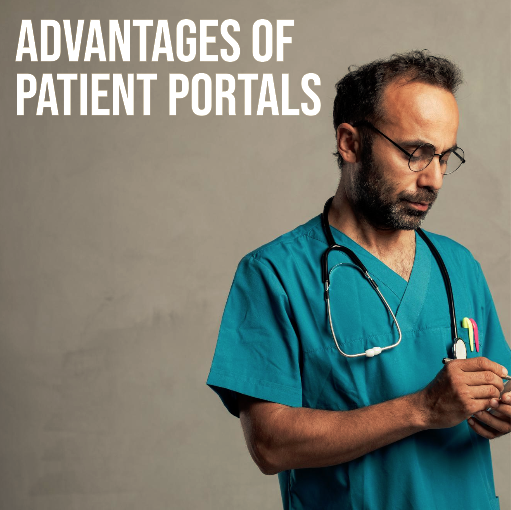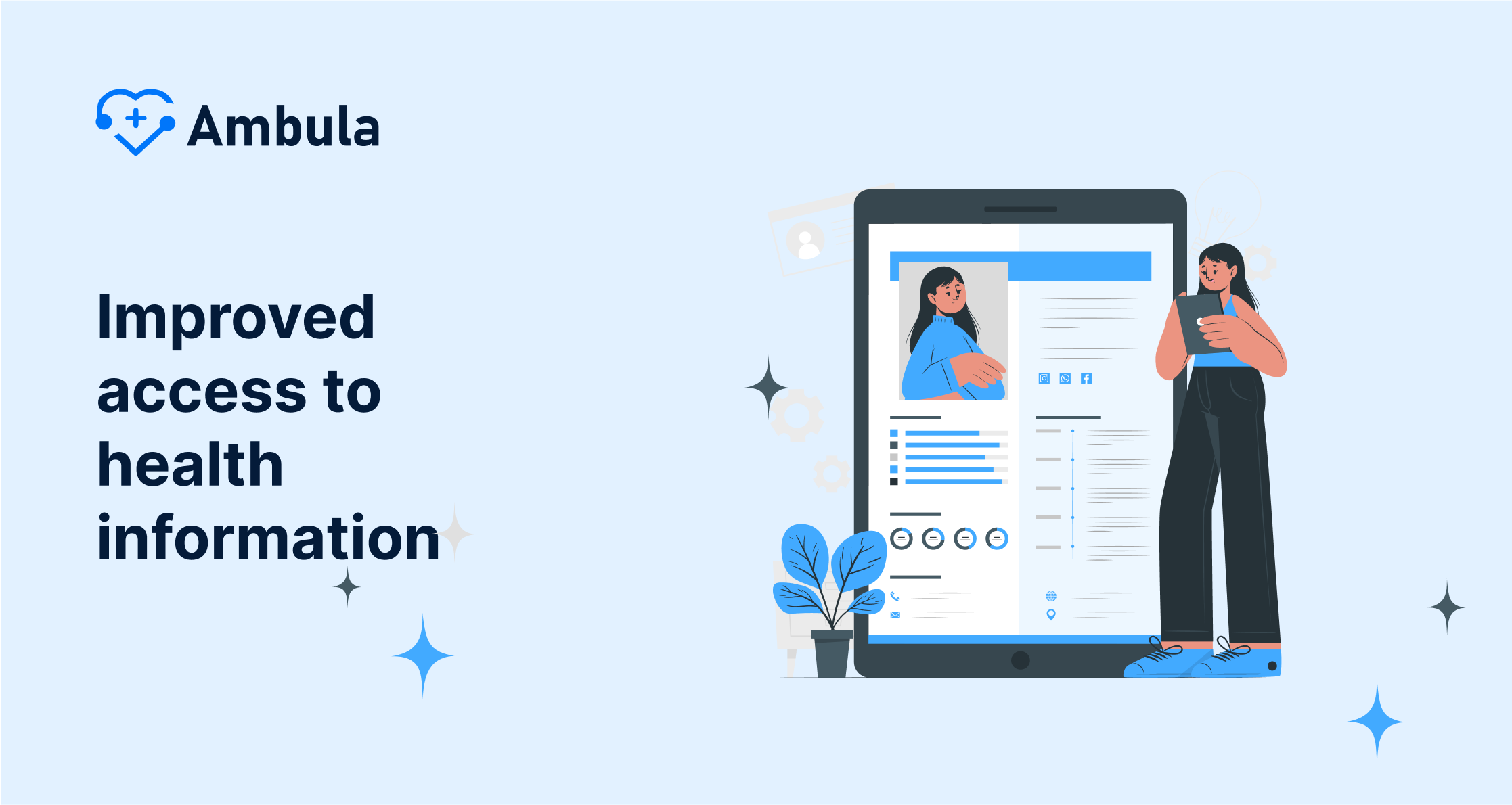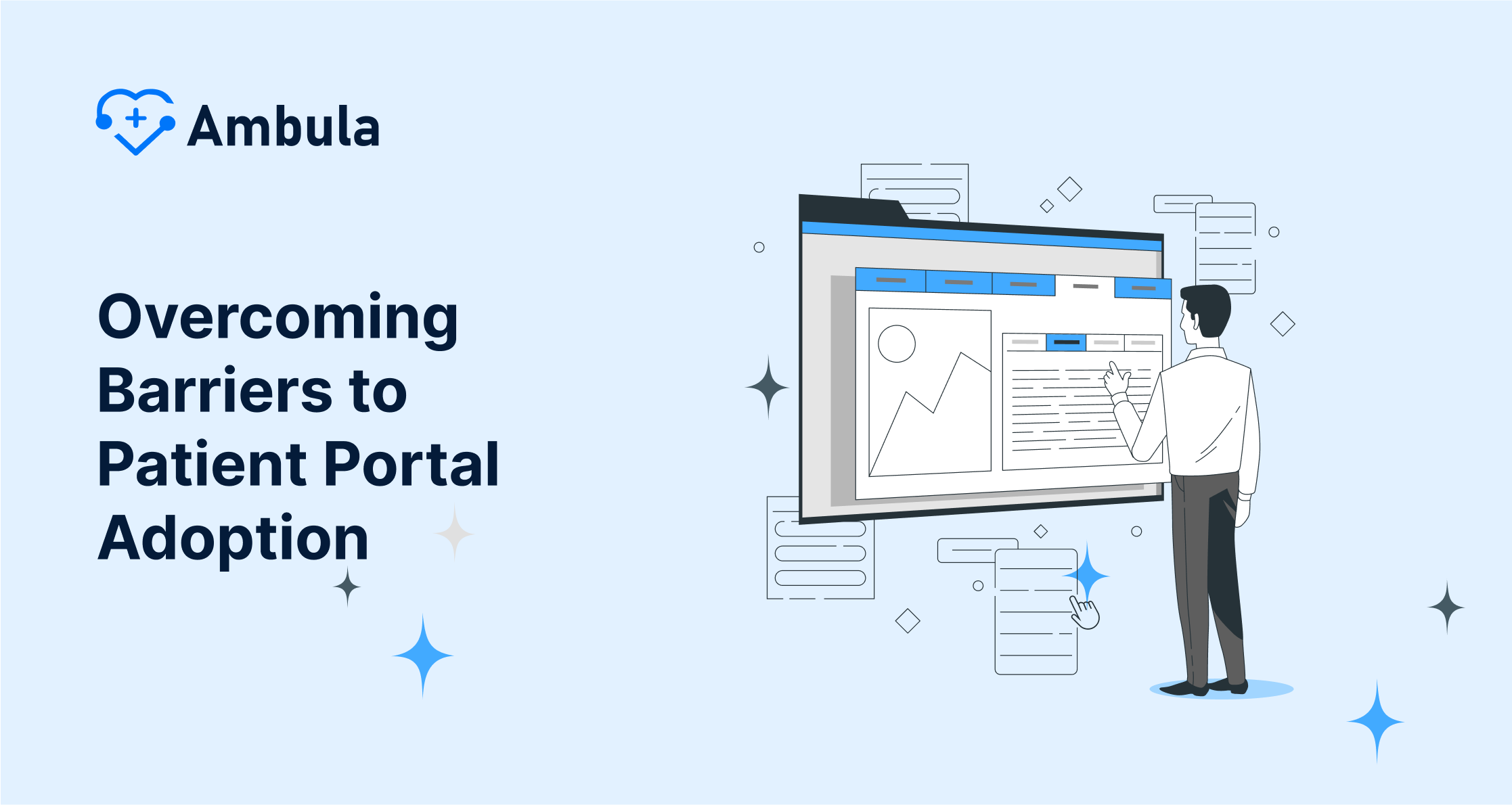
Patient portals are secure websites or apps that let patients see their medical records, test results, and other health info. They also allow patients to book appointments ask for prescription refills, and talk to their doctors.
These portals have benefits for both patients and healthcare workers. Patients can check their health information, talk better with their doctors, and take part more in their healthcare. For healthcare workers, these portals can make office work easier, help patients get more involved and communicate better, and improve care coordination.
A 2023 HIMSS Analytics survey shows that 90% of healthcare organizations provide a patient portal. Yet just 63% of patients report using a patient portal in the last year. This points to plenty of potential to boost the adoption and use of patient portals.

Patient portals offer secure entry to your electronic health record (EHR) day and night, anyplace you’ve got a web connection. You can peek at your medical past peering into lab outcomes, image reports, and lists of meds whenever it suits you. Plus, downloading and sharing your EHR with different health pros, like experts or urgent care centers, is a piece of cake.
Better entry to health info can bring on all sorts of good stuff, like:
- Grasping your health history better: If you can peek at your medical records whenever you want, you’ll get the whole picture of your health, spot risks lurking around, and choose smarter when it comes to your treatment.
- Chatting better with your doc: Skim your medical history before you see the doctor and you can chat way more effectively with them. That way, you both can work together smoother and fine-tune the care you get.
- Getting more on board with your health stuff: Those patient portals? They’re ace for pushing you to get more stuck into looking after your health. With your med records just a click away and a direct line to your doc, you’re well set to take the reins on your health journey.
Say you’re about to meet a new doctor to get some specialized care. Well, you can log into your patient portal and look over your health history before you head in. Doing this, you can figure out any stuff you’re curious or uneasy about, and it’ll also make it easier for the doc to get what you need health-wise.
Or say you’ve got to start popping some brand-new pills. Poke around your patient portal to learn about the possible side effects and how this drug might clash with others. Getting to know this stuff is super important for staying on top of your health game while on new meds.
Managing long-term health problems gets a bit easier with patient portals too. Take diabetes, for instance. You can keep track of your sugar levels in the portal and share ’em with your doctor. With this info, your doctor can make the right tweaks to how they’re treating your diabetes.
Benefits of Patient Portals for Healthcare Providers
Patient portals offer several benefits for healthcare providers, including streamlined administrative tasks, improved patient engagement and communication, and better care coordination.
Especially in mental health practices, using a mental health EHR software within the patient portal can further enhance care coordination by providing direct access to therapy notes and real-time updates on patient progress.
Streamlined administrative tasks
Patient portals can automate many time-consuming administrative tasks, such as scheduling appointments, processing prescription refills, and answering patient questions. This can free up staff to focus on more important tasks, such as providing patient care.
For example, a patient can use the portal to schedule their appointment rather than having to call the office and wait on hold. The portal can also process prescription refills automatically so that patients don’t have to call or come into the office to request them.
Improved patient engagement and communication
Patient portals make it easy for patients to communicate with their providers and access their health information. This can lead to improved patient engagement and satisfaction.
Patients can use the portal to ask questions about their health conditions, request appointments, and refill prescriptions. They can also view their medical records, test results, and immunization records. This can help patients to understand their health better and make informed decisions about their care.
For example, patients can use the portal to learn more about a new medication they are prescribed or ask their doctor about a test result. The portal can also share health information with family members or caregivers.
Stats:
- A 2020 Office of the National Coordinator for Health Information Technology survey found that 52% of patients who used a patient portal reported feeling more engaged in their healthcare.
- A 2021 study published in the journal Patient Education and Counseling found that patients who used a patient portal were more likely to have better blood sugar control than patients who did not use a patient portal.
- A 2022 study published in the journal JMIR Medical Informatics found that patients who used a patient portal to communicate with their healthcare provider were more satisfied with their care than patients who did not use a patient portal to communicate with their healthcare provider.
Breaking Down Hurdles in Patient Portal Use
Diving into Hurdles
- Background: Clear perks exist with patient portals, yet hurdles in embracing them remain. It’s essential for healthcare pros to grasp these obstacles and tackle them to tap into patient portals’ possibilities.
- Typical Hurdles: Obstacles span from tech issues and missing awareness to a reluctance to shift, affecting patients and healthcare workers alike.
Tech Problems and Fixes
- Digital Divide: The gap in tech access known as the digital divide, can leave some patients without the tech or internet they need. It’s a big problem for older people, folks with low incomes, and those living out in the country.
-
- Solution: To tackle this, healthcare pros might set up computer spots in their offices or team up with local centers to make access easier.
- Usability Issues: Some patient portals can also be hard to use or just not user-friendly.
-
- Solution: Crafting portals that are easy to understand and offering some kind of training or how-to guides can make these portals easier to use for everyone, no matter how much they know about tech.
Awareness and Education
- Not Knowing Much: Loads of folks don’t even know patient portals are a thing or what’s good about ’em.
-
- What to Do: Docs and clinics could spread the word by handing out pamphlets and spiffing up their websites with the lowdown on these portals when people come in.
- Need for Help: Even if some get the idea of patient portals, they might be scratching their heads on how to make ’em work right.
-
- What to Do: If hospitals give out how-tos that are a piece of cake to get, run some workshops, and stick around to help out anytime more peeps might start clicking around on these handy tools.
Folks From Different Places Talking Different
- Patients from Different Cultures: Those coming from various cultural settings or speaking multiple languages might struggle with patient portals that don’t cater to their unique requirements.
-
- Fix: Offering support in several languages and providing materials sensitive to culture can help make patient portals more welcoming.
Worries on Private and Secure Matters
- Data Security Fret: A bunch of patients worry about keeping their health details private and safe online.
-
- Fix: Teaching patients about the safety stuff we got, like codes that no one else can crack and ways to log in that are super secure, might ease their worries. Checking and making security stuff better all the time is mega important too.
Improving Care Teamwork
Healthcare pros like docs, nurses, and expert docs can swap details through patient portals. This has an influence on the care’s teamwork ensuring folks get top-notch help.
Say a patient’s expert doc might pop their test outcomes and tips into the portal for the main doc to peep. It’s handy for setting up meet-ups with various pros and sorting out who sends ya where.
Patient portals are pretty rad for those in the health game. They make less work of the paper-pushing stuff, jack up the talking and the involvement of patients, and trigger better teaming up for health dudes to level up the care they give and make patients’ time better.
Most Seen Stuff in Patient Portals
Patient portals boast a bunch of cool tools that make handling health stuff way easier. Check out the usual things these portals have:
- Peeking at health files: Folks can check out their own health records on the patient portal. They get to see stuff like test results, shots they’ve had, and what meds they’re on. Knowing all this is pretty handy when they have to make choices about their own health.
- Chit-chat with docs over a secure line: The patient portal lets people shoot messages back and forth with their doctors. It’s super useful for firing off quick questions setting up times to see the doc, or getting more pills without calling in.
- Putting down times to see the doc: Through the patient portal, people can book their own meetings with doctors online. It’s a real time-saver and cuts out the frustration. Plus, it makes sure folks keep on track with the stuff they gotta do to stay healthy.
- Ordering more meds: You got the power to top up your prescriptions right from the patient portal. Super handy, right? Plus, it keeps you from that ‘oh-no-I’m-out-of-pills’ moment.
- Peeking at test outcomes: Want to check out how you did on those health tests? Just hop onto the patient portal. Knowing what’s up with your health becomes way easier. Plus, you can watch how things change as time goes on.
- Health know-how on tap: These patient portals aren’t joking around; they’ve got a whole library of info on different health stuff, ways to treat it, and how to stop problems before they start. Read up, and you’re all set to call the shots on your health game.
Patients often have the means to settle their medical invoices online via the patient portal. This method offers a handy route to manage bills and monitor payment histories.
Picking Out a Patient Portal
So, you gotta pick out a patient portal for your medical practice. Start by thinking about the features you and your patients need. Like, you might want them to peek at their medical records, send secure messages, book appointments, ask for more meds, look at test results, learn from health info, and pay their bills online.
Then, you should sort out how this portal is gonna work with your electronic health record (EHR) system. You gotta make sure all patient details are in sync across every system so taking care of your patients is a breeze for you and your team.
Think about how simple the patient portal is to use. This sucker needs to be a no-brainer, with obvious directions and a smooth way to get around. Plus, keeping patient details safe with top-notch security stuff is a must.
Don’t forget about the dollars and cents part either. With these patient portals, you might have to cough up cash at the start or keep paying as you go. And some might hit you with extra charges for extra stuff. Be smart and pick a portal that won’t break the bank but still does what you need.
When you’ve looked over all these details, it’s time to trim your options. Check out different patient portals by reading online critiques or get tips from other health pros. After picking some that fit what you need why not snag a no-cost trial or demo to test them out for real?
Got more stuff on your mind about selecting a patient portal? Check this out:
Ensure the patient portal works on phones and tablets. A growing number of patients use these devices to look up health info so pick a portal that’s good for mobile use.
Think about what your patients need. If a lot of your patients are older, a portal with bigger text and easy-to-use menus might be the best choice.
Chat with your team for input. Ask them which features they want in a patient portal and how it could make their work simpler.
Top Patient Portals Out There
According to KLAS Research here’s a list of well-liked patient portals:
Epic (MyChart)
MyChart leads the pack in patient portals with a solid score of 89.1 from KLAS. You can do a bunch of stuff with it—like check your medical history, make doctor’s appointments, chat with your healthcare peeps, and get your meds without a hassle.
Athenahealth (AthenaCommunicator)
Just a step behind, AthenaCommunicator snagged a pretty good 84.6. Folks dig it because it’s a breeze to use and it plays nice with a bunch of other health-tech stuff.
Greenway Health (Greenway Patient Portal)
Then there’s Greenway Patient Portal scoring 77.9. People give it thumbs up for its handy app and being super helpful for speakers of different languages.
NextGen Healthcare’s “Medfusion Patient Portal”
With a score of 58.1, “Medfusion Patient Portal” from NextGen Healthcare nails the fifth spot. Patients seeking a simple and wallet-friendly patient portal will find it decent.
Maximizing Benefits from Patient Portals
Picking a suitable patient portal might crank up patient involvement smooth out office jobs, and lead to enhanced patient health care.
Patient portals bring a bunch of pluses for both folks working in health centers and the sick people who come in. If healthcare buff want these portals to rock, they’ve got to push patients to hop on board, make the sign-up a no-brainer, tell them to chat through these portals, slip them health updates on it, and make sure it goes hand-in-hand with EHR systems.
On the flip side, patients should join one of these portals, keep their details fresh, dig into their health deets on it, hit up their health pros with it, and let their care buddies in on their account deets.
If everyone sticks to these pointers, they’ll squeeze all the good stuff outta patient portals.
Tackling Possible Hurdles
Though patient portals bring lots of pluses, getting them in place and getting people to use them can throw up some tough stuff that healthcare places gotta tackle head-on.
Tech Gap and Getting to Everyone
A big hurdle with setting up patient portals is making sure everyone gets a fair shot at using them. We’re talking folks of all tech levels, cash situations, or what their bodies can do. Healthcare spots need to hustle and come up with ways to bridge the tech gap. They’ve got to hand out guidance and help stuff, find other ways for peeps without the net or a computer to get in, and make sure the portals are doable for peeps with disabilities.
Keeping Data Safe and To Yourself
Security and keeping things private with patient info is another biggie. Healthcare crews have to keep a tight grip on this to make sure nothing bad goes down.
Healthcare organizations prioritize the security and privacy of sensitive personal health information (PHI) in patient portals. They must put in strong defenses like encrypting data using multi-factor identification, and conducting frequent security checks. This keeps patient info safe from illegal entry and online dangers. Also, they’ve gotta set up straightforward rules and ways to follow important data privacy laws like the “Health Insurance Portability and Accountability Act” (HIPAA).
Shifting Stuff and Getting People to Use It
When healthcare places roll out fresh tech, docs and their patients might not be so keen on it. To make patient portals take off, health groups gotta have solid strategies for managing changes. They need full-on training stuff, help that doesn’t quit, and they gotta talk up how cool and useful these portals are. Gettin’ everyone on board and listening to what bugs them can tone down pushback and pump up a vibe where folks use ’em and think they’re alright.
Hooking Up with Stuff They Already Got
When you mix patient portals into current electronic health record systems and other healthcare tech stuff, you can run into some techy probs. Health groups gotta make sure all the data fits together nice and neat so there aren’t any mix-ups or double-ups that could mess with keeping patients safe and giving them top-notch care. It’s super important to team up with IT pros and the folks selling the systems to dodge these tech headaches and make everything come together without a hitch.
Conclusion
Patient portals are a valuable tool for both healthcare professionals and patients. By providing patients with convenient access to their health information, improving communication with providers, and increasing engagement in healthcare, patient portals can help to improve the quality of care patients receive.
Healthcare professionals can also benefit from patient portals by streamlining administrative tasks, improving patient engagement, and better coordinating care. By promoting the use of patient portals and making it easy for patients to sign up, healthcare professionals can help to ensure that all patients can reap the benefits of this technology.
Patient portals are a key part of the future of healthcare. By providing patients with more control over their healthcare and by making it easier for providers to deliver care, patient portals are helping to create a more patient-centered and efficient healthcare system.






